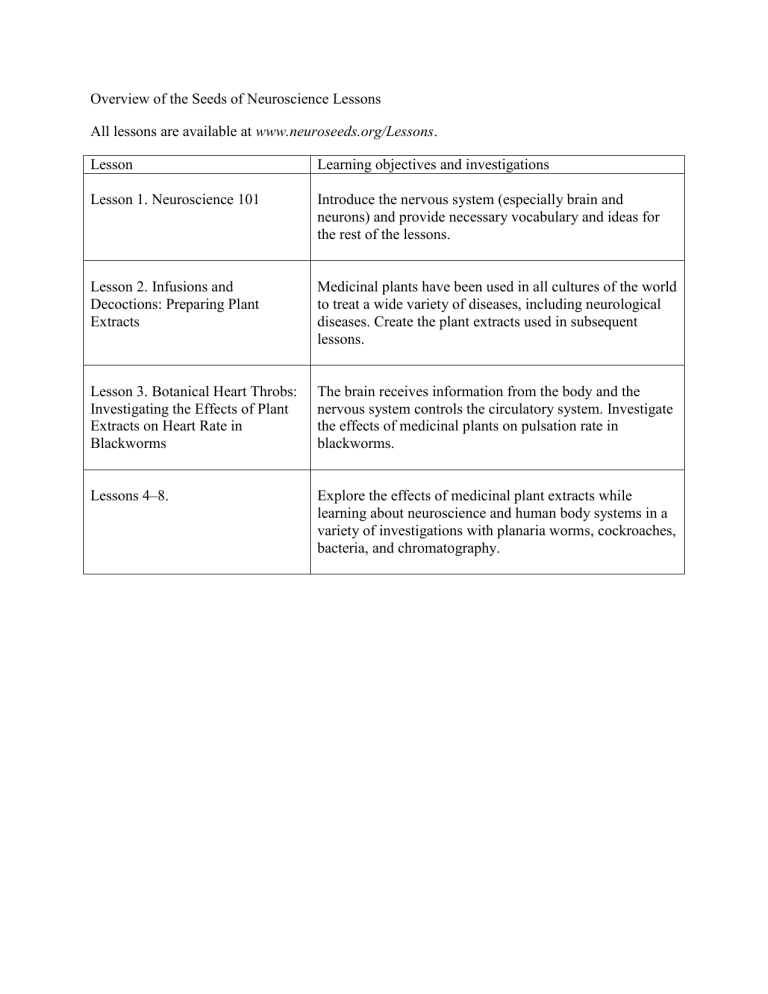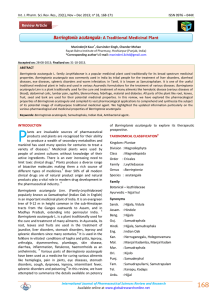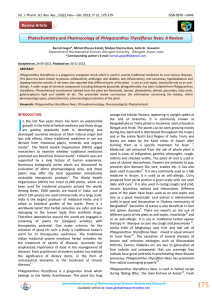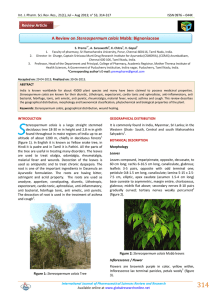Overview of the Seeds of Neuroscience Lessons

Overview of the Seeds of Neuroscience Lessons
All lessons are available at www.neuroseeds.org/Lessons .
Lesson
Lesson 1. Neuroscience 101
Lesson 2. Infusions and
Decoctions: Preparing Plant
Extracts
Lesson 3. Botanical Heart Throbs:
Investigating the Effects of Plant
Extracts on Heart Rate in
Blackworms
Lessons 4–8.
Learning objectives and investigations
Introduce the nervous system (especially brain and neurons) and provide necessary vocabulary and ideas for the rest of the lessons.
Medicinal plants have been used in all cultures of the world to treat a wide variety of diseases, including neurological diseases. Create the plant extracts used in subsequent lessons.
The brain receives information from the body and the nervous system controls the circulatory system. Investigate the effects of medicinal plants on pulsation rate in blackworms.
Explore the effects of medicinal plant extracts while learning about neuroscience and human body systems in a variety of investigations with planaria worms, cockroaches, bacteria, and chromatography.
Example class data table
Group
Plant extract
Prediction:
Stimulant or depressant?
Result:
Increase, decrease, or stay the same?
Hypothesis:
Supported or refuted?
A B C D E
Rubric
Additional rubrics for this curriculum are available at www.neuroseeds.org/Lessons/heartthrobs.
[Please update.]
Dimension
Records data and observations.
Needs work
(0 Points)
Data in the table are not accurate or cannot be read.
Basic
(1 Point)
Data in the table are accurate and easy to read.
Proficient
(3 Points)
Data in the table are accurate and easy to read.
Some observations recorded.
N/A
Advanced
(5 Points)
Data in the table are accurate and easy to read.
Detailed observations recorded.
N/A Names the plant extract tested by the group.
Provides hypothesis for the plant extract.
Includes a description of how the plant extract affected pulsation rate.
States whether observations supported hypothesis and supports this statement with evidence.
Incomplete or incorrect.
Incomplete or incorrect.
No description provided.
No conclusion was apparent or important details were overlooked.
Correctly names the plant extract.
Provides a hypothesis for the plant extract tested.
Somewhat clearly described the changes in the pulsation rate among the control and the plant extract.
N/A
Provides a conclusion with some reference to the data and the hypothesis.
N/A
Clearly described the changes in the pulsation rate among the control and the plant extract.
Provides a somewhat detailed conclusion based on the data and related to the hypothesis.
Clearly described the changes in the pulsation rate among the control and the plant extract.
Supported description with evidence.
Provides a detailed conclusion clearly based on the data and related the hypothesis statement.











